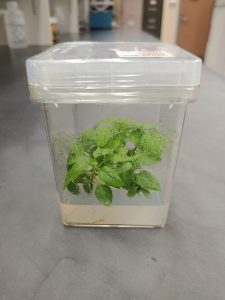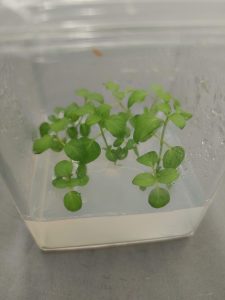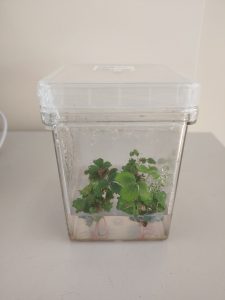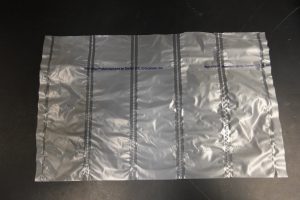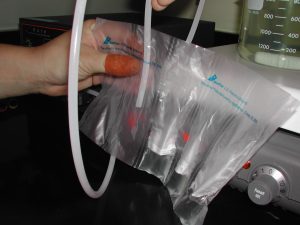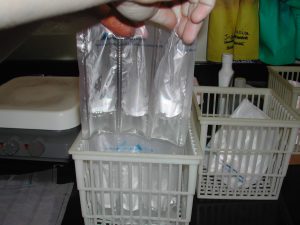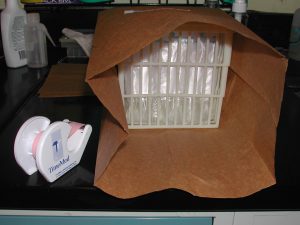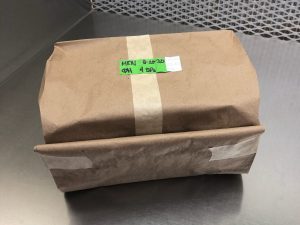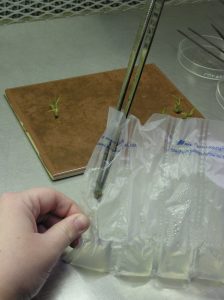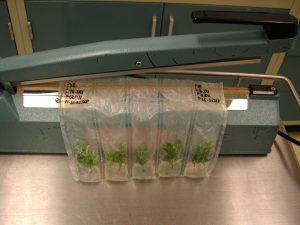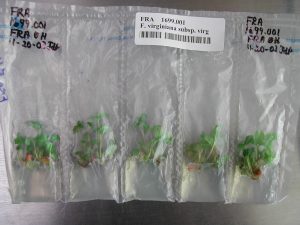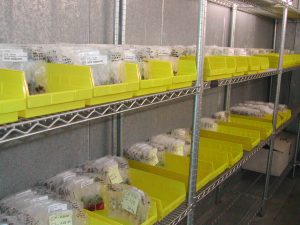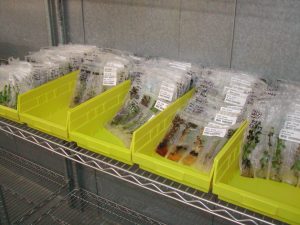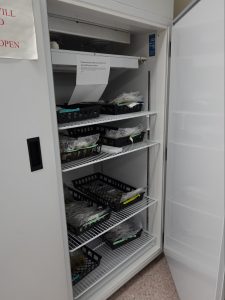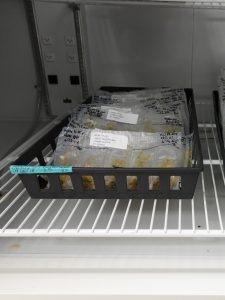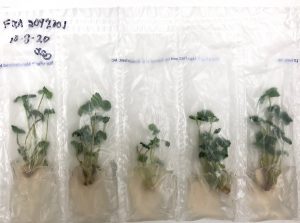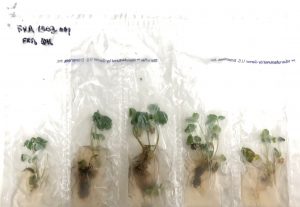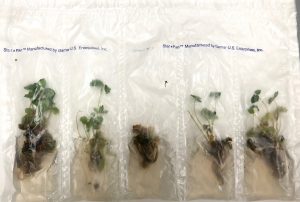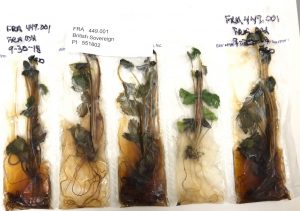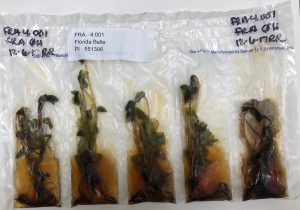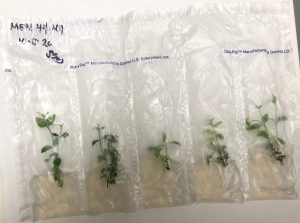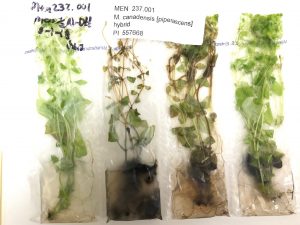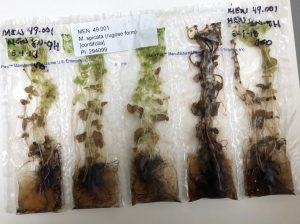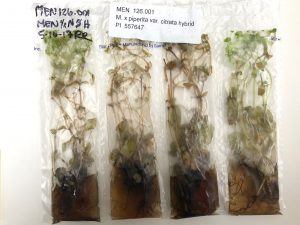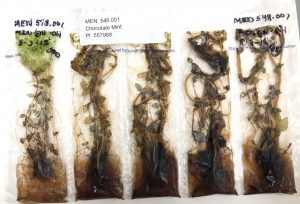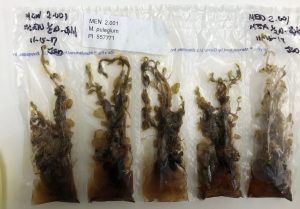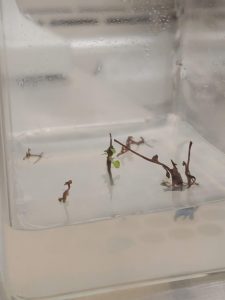Reduced-Temperature Storage of Temperate Crops in Tissue Culture
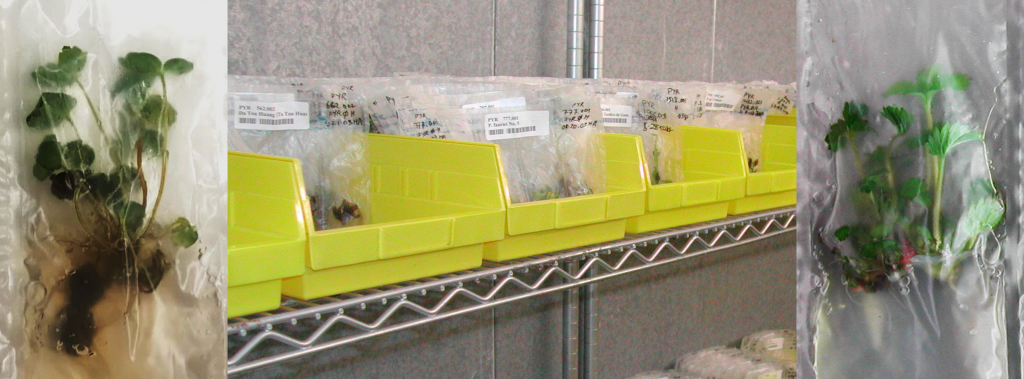
Gayle M. Volk, USDA-ARS National Laboratory for Genetic Resources Preservation (retired), 1111 S. Mason St., Fort Collins, Colorado 80521. Gayle.Volk@colostate.edu
Jeanine DeNoma, USDA-ARS National Clonal Germplasm Repository, 33447 Peoria Road, Corvallis, Oregon 97333.
Kim Hummer, USDA-ARS National Clonal Germplasm Repository, 33447 Peoria Road, Corvallis, Oregon 97333.
Katheryn Chen, Department of Soil and Crop Sciences, Colorado State University, 307 University Ave., Fort Collins, Colorado 80523.
Outline
- Introduction to reduced-temperature storage
- Preparation of in vitro cultures
- Storage conditions
- Viability assessment
- Culture maintenance
- References
- Additional information
- Acknowledgments
1. Introduction to reduced temperature storage
Some plant genebank collections have been introduced into tissue culture. Plants in tissue culture can be maintained in a form that is free of diseases, protected from pathogens, kept in a relatively small space, and can be easily duplicated at several sites; however, in vitro plants require significant levels of technical support for maintenance and may experience somaclonal variation, depending on crop, media conditions, and storage duration.
Reduced-temperature storage is a method that has been implemented by genebanks to prolong the time intervals between tissue culture transfers, thus minimizing some drawbacks of in vitro collections. Conditions such as temperature, sample preparation, and storage vessel, are dependent on the crop, but storage duration is typically between 9 and 24 months (or longer) (Reed 1999; Reed 2002). Plants stored at reduced temperatures can be warmed, repropagated, and then either returned to reduced-temperature storage or used for other purposes. These plants may be made available for distribution or for processing as long-term cryopreserved back-ups (see chapters in the “shoot tip cryopreservation” section).
This chapter describes and demonstrates methods for in vitro storage of mint (Mentha) and strawberry (Fragaria), both temperate crops that have been stored at 4 oC at the National Clonal Germplasm Repository in Corvallis, Oregon and at 5 oC the National Laboratory for Genetic Resources Preservation in Fort Collins, Colorado, as part of the USDA-ARS National Plant Germplasm System (NPGS).
2. Preparation of in vitro cultures
Plant materials are either received as in vitro plants or are introduced from field or greenhouse conditions. Introduction methods are described in the chapter, “Introduction of Plants into Tissue Culture“. Once introduced into tissue culture and confirmed to be free of endophytic contamination, they are placed onto medium that causes the plants to proliferate, or multiply (Fig. 1, 2). Multiplication conditions for mint and strawberry are provided by Reed (1999; 2002).
Figure 1. In vitro cultures of mint that will be transferred into polyethylene bags for reduced-temperature storage. Photo credit: Katheryn Chen.
Figure 2. In vitro cultures of strawberry that will be transferred into polyethylene bags for reduced-temperature storage. Photo credit: Katheryn Chen.
In the NPGS, mint and strawberry plants are placed at 4 to 5 oC reduced-temperature storage within polyethylene bags (also referred to as Star*Pac® bags). The bags are purchased as 12 inch by 9 inch sheets with 5 cells (Fig. 3). These bags are filled with a minimal amount of medium (10 mL per cell), plants are placed into individual cells, and the bag is sealed to minimize contamination.
Figure 3. A five-cell Star*Pac® polyethylene bag used for reduced-temperature storage. Photo credit: Katheryn Chen.
The medium for reduced-temperature storage might be different from that for standard propagation activities. For strawberry and mint, there are no plant growth regulators and there is an increased level of agar. The mint medium also has a reduced nitrogen level (Reed 1999; Reed 2002).
To make the medium, the components are combined in a flask, pH is adjusted, and then agar is added. The medium is brought to a boil to dissolve the agar. The hot medium (10 mL per cell) is dispensed into each cell of the bags. Medium is placed at the bottom of each cell without dripping medium along the sides or the opening, where it might interfere with the seal and become a source of contamination (Fig. 4).
The open Star*Pac® bags are loosely (gently) placed into an autoclave-safe basket without pressing the sides of the Star*Pac® bags to maintain a flat planting surface on the medium. The soft medium should not be pressed up the sides of the bags. If necessary, the Star*Pac® bag can be gently folded along the seam between cells to fit in the basket (as shown in Fig. 4). The seams of an appropriately sized paper grocery bag are sealed with masking tape to keep them intact during the autoclave process. The basket with the Star*Pac® bags is enclosed in the paper bag and taped shut (Fig. 5). The sealed bag is then labeled with autoclave tape, the type of medium, and the number of Star*Pac® bags, and then it is sterilized in an autoclave for 20 to 25 minutes.
Figure 4. Dispensing medium into each cell of the polyethylene bag (left) and placement of bags into baskets for sterilization (right). Photo credit: Jeanine DeNoma.
Figure 5. Packaging rack of polyethylene bags into paper bag for sterilization (left) and sealed paper bag prior to autoclaving (right). Photo credit: Jeanine DeNoma.
In a sterile laminar flow hood, one three-week old plant segment (2 to 5 cm) is placed into each cell (Fig. 6). When the bag is loaded, excess air is removed and sealed with an impulse heat sealer (Fig. 7). This process is shown in Video 1. It is important to achieve a smooth seal across the top of the bag. It is also critical that there is no medium or plant material trapped in the seam or along the top of the bag where sealed, as this this will produce a poor seal and could result in a contaminated culture. The bag is labeled with information about the crop, including local identification number, date, and possibly a bar code for inventory tracking purposes.
Video 1. Technician Jeanine DeNoma prepares mint cultures for reduced-temperature storage in Star*Pac® bags. Video credit: Kim Hummer. (Silent video)
Figure 6. Placement of sterile plant tissue into polyethylene bag in preparation for reduced-temperature storage. Photo credit: Jeanine DeNoma.
Figure 7. Sealing polyethylene bags for storage (left) and prepared, labeled bag of strawberry plants for reduced-temperature storage (right). Photo credit: Jeanine DeNoma.
When the shoots are sealed in Star*Pac® bags, the bags are placed under light in the growth room for 1 week (25 oC, 16-h photoperiod, 25 mmol m-2 s-1 photo-synthetic photon flux (PAR)). After 1 week in the growth room, the Star*Pac® bags are transferred to cold acclimation conditions for 1 week, with short days and long, cold nights (8 h, 22-24 oC day/ 16 h, -1 oC night).
3. Storage conditions
After cold acclimation, plants are placed into 4 oC storage rooms (at the Corvallis location, Fig. 8) or in a reach-in chamber set at 5 oC (at the Fort Collins location, Fig. 9). They are a maintained under a 12-h photoperiod with a light level of 0.5 to 15 µmol m-2 s-1.
At minimum, two sets of 5-Star*Pac® bags are prepared per accession, and the two sets of samples are stored at duplicate locations (in this example, they are kept in Corvallis, Oregon and Fort Collins, Colorado).
Figure 8. Polyethylene bags on racks in reduced-temperature storage room at the National Clonal Germplasm Repository in Corvallis, Oregon. Photo credit: Barbara Reed.
Figure 9. Polyethylene bags on racks in reach-in chamber at 5 oC at the National Laboratory for Genetic Resources Preservation in Fort Collins, Colorado. Photo credit: Katheryn Chen.
4. Viability assessment
Plant vigor assessments must be periodically conducted to ensure the stored material is still viable. These assessments are typically performed every three months, although some crops may require more frequent viability assessments, depending on how quickly the plants decline in cold-storage.
Rating systems have been developed to classify the quality of the plants. An appropriate vigor scale is developed for each crop, depending on the quality of plant material needed for successful rejuvenation. In some cases, leaves may be green, but the plant can not be repropagated. The key is that the meristematic regions must remain alive.
A vigor scale from 1 to 5 serves for rating the plant quality, based on visual inspection as described by Reed (1999) and personal experiences of the author (DeNoma). According to the vigor scale below, plants with a rating of 2 are at risk of being lost before the next assessment period, and must be immediately repropagated.
5 = dark green leaves and stems, no etiolation
4 = green leaves and stems, little etiolation
3 = shoot tips and upper leaves green, some etiolation
2 = shoot tips green, leaves and stems mostly brown, base may be dark brown
1 = plant mostly to totally brown, no visible green on shoot tip
Some researchers rate the quality of the 5-cell Star*Pac® as a whole, but others rate each cell individually. If plants are rated as a set of 5 (rather than individually), then an overall average assessment is made, based roughly on the same criteria.
Below are some examples of the rating system applied to strawberry plants after reduced-temperature storage (Fig. 10, 11, 12, 13, 14).
Figure 10. Example of strawberry plants after reduced-temperature storage: Leaves are dark green and plants are not etiolated. Rating scale level 5. Photo credit: Jeanine DeNoma.
Figure 11. Example of strawberry plants after reduced-temperature storage: Leaves are mostly green and there are some signs of etiolation and leaf browning. Rating scale level 4. Photo credit: Jeanine DeNoma.
Figure 12. Example of strawberry plants after reduced-temperature storage: A range in plant quality is evident, with some plants appearing green and non-etiolatead, and others with etiolation and browning leaves. The middle cell has declined significantly. Rating scale level 3. Photo credit: Jeanine DeNoma.
Figure 13. Examples of strawberry plants after reduced-temperature storage: Overall, shoot tips are green, leaves and stems are mostly brown. Plants need repropagation. Rating scale level 2. Photo credit: Jeanine DeNoma.
Figure 14. Example of strawberry plants after reduced-temperature storage: Plants are mostly to totally brown and might not be successfully recovered. Rating scale level 1. Photo credit: Jeanine DeNoma.
In the images below, the rating system is applied to mint plants after reduced-temperature storage (Fig. 15, 16, 17, 18, 19).
Figure 15. Example of mint plants after reduced-temperature storage: Leaves are dark green and plants are not etiolated. Rating scale level 5. Photo credit: Jeanine DeNoma.
Figure 16. Examples of mint plants after reduced-temperature storage: Leaves are mostly green and there are some signs of etiolation and leaf browning. Rating scale level 4. Photo credit: Jeanine DeNoma.
Figure 17. Examples of mint plants after reduced-temperature storage: A range in plant quality is evident, with some plants appearing green and non-etiolated, and others with etiolation and browning leaves. Rating scale level 3. Photo credit: Jeanine DeNoma.
Figure 18. Example of mint plants after reduced-temperature storage: Overall, shoot tips are green, leaves and stems are mostly brown. Plants need repropagation. Rating scale level 2. Photo credit: Jeanine DeNoma.
Figure 19. Example of mint plants after reduced-temperature storage: Plants are mostly to totally brown and might not be successfully recovered. Rating scale level 1. Photo credit: Jeanine DeNoma.
5. Culture maintenance
The storage duration at reduced temperatures depends on the crop, specific culture, and culture conditions. Reed (1999) suggested that in vitro mint plants can be stored for a minimum of 24 to 36 months before subculturing is required. Strawberry plants can be held 9-24 months at 4 oC; they might need to be repropagated within 12 months (Reed 2002).
Material determined to need repropagation must first be warmed, sterilized, and placed into tissue culture (Video 2) before it may be repropagated and returned to cold storage.
Surface sterilization of the Star*Pac® bags is particularly critical before the plants are removed from the bags as the outside of the bags may harbor a variety of contaminants. Star*Pac® bags are washed in 20% bleach (concentration) for 10 minutes and rinsed in tap water. They are then air-dried (usually overnight). Star*Pac® bags are sprayed with 70% ethanol and wiped as they are introduced to a laminar flow hood. Plants may then be carefully removed from their cells, and planted in a shoot growth medium appropriate for the crop type (Fig. 20).
Video 2. Technician Jeanine DeNoma transfers mint plants from Star*Pac® bags into culture vessels. (Silent video) Video credit: Kim Hummer.
Figure 20. In vitro cultures of mint that were recovered from vigor stage 2 for repropagation after reduced-temperature storage. Photo credit: Katheryn Chen.
6. References
Reed BM. 1999. In vitro storage conditions for mint germplasm. HortScience 34:350-352.
Reed BM. 2002. Photoperiod improves long-term survival of in vitro-stored strawberry plantlets. HortScience 37:811-814.
7. Associated information
Star*Pac® bags are a registered trademark of Garner U.S. Enterprises, Inc. of Willis, Texas. The use of trade, firm, or corporation names in this chapter is for the information and convenience of the reader. Such use does not constitute an official endorsement or approval by the United States Department of Agriculture or the Agricultural Research Service of any product or service to the exclusion of others that may be suitable.
8. Acknowledgments
Citation: Volk GM, DeNoma J, Hummer K, Chen K. 2021. Reduced-temperature storage of temperate crops in tissue culture. In: Volk GM (Eds.) Training in Plant Genetic Resources: Cryopreservation of Clonal Propagules. Fort Collins, Colorado: Colorado State University. Date accessed. Available from https://colostate.pressbooks.pub/clonalcryopreservation/chapter/reduced-temperature-storage-of-temperate-crops-in-tissue-culture/
This training module was made possible by:
Editors: Gayle Volk, Katheryn Chen
Content providers: Jeanine DeNoma, Katheryn Chen, Kim Hummer
Methods developed by: Barbara Reed and Carolyn Paynter
This project was funded by the USDA-ARS and and by the USDA-NIFA Higher Education Challenge Program grant 2020-70003-30930.
USDA is an equal opportunity provider, employer, and lender. Mention of trade names or commercial products in this article is solely for the purpose of providing specific information and does not imply recommendation or endorsement by the U.S. Department of Agriculture.

